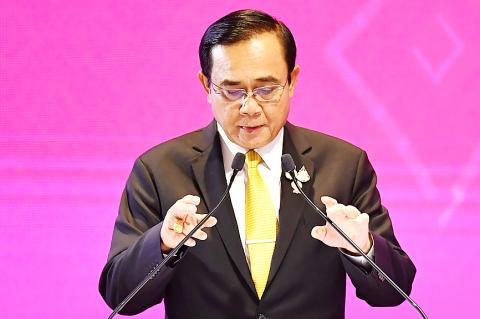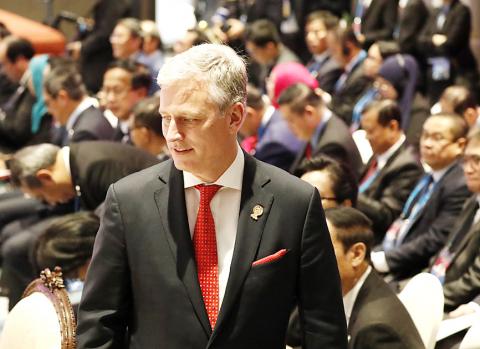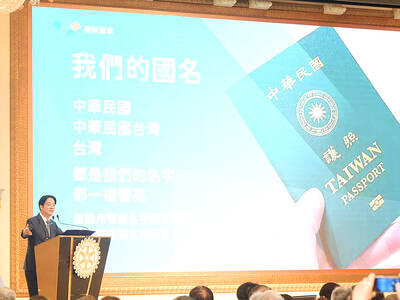Fifteen Asia-Pacific countries have concluded negotiations for a trade pact that would be among the world’s largest, but India still has “significant outstanding issues” before it is ready to sign on, the countries’ leaders said yesterday.
A summit of the leaders of the Regional Comprehensive Economic Partnership (RCEP) left open the door for India to join if it can resolve issues before the deal is set to be signed next year.
India has balked at exposing its farmers and factories to more foreign competition, especially from China.

Photo: AFP
Fifteen of the 16 prospective RCEP states “have concluded text-based negotiations for all 20 chapters and essentially all their market access issues,” said the leaders’ statement, which included India.
“RCEP will significantly boost the region’s future growth prospects and contribute positively to the global economy,” the statement said.
South Korean President Moon Jae-in said there was a need to bring the global economy back on track, adding: “We are once again faced with the high winds of trade protectionism … we need to protect the free-trade order.”

Photo: EPA-EFE
The RCEP nations include the 10 ASEAN members, plus China, Japan, South Korea, Australia and New Zealand
Meanwhile, just three ASEAN leaders showed up yesterday for a meeting with US officials, after US President Donald Trump decided not to attend the summit in Bangkok.
Only Thai Prime Minister Prayuth Chan-ocha and the leaders of Laos and Vietnam, along with several foreign ministers, attended.
Washington did not send top officials to the summit, just US Secretary of Commerce Wilbur Ross and National Security Adviser Robert O’Brien.
Yesterday’s address from O’Brien stood in contrast to earlier ASEAN meetings, which had all been attended by most heads of state.
“It’s not appropriate for ASEAN to send leaders when the US representation is not on parity,” one diplomat said.
Another diplomat said: “It’s not a boycott, it’s just that other leaders have other meetings to attend to.”
In lieu of Trump’s physical presence, O’Brien read a letter from the president inviting “the leaders of ASEAN to join me in the United States for a special summit” at some point during the first three months of next year.

LONG FLIGHT: The jets would be flown by US pilots, with Taiwanese copilots in the two-seat F-16D variant to help familiarize them with the aircraft, the source said The US is expected to fly 10 Lockheed Martin F-16C/D Block 70/72 jets to Taiwan over the coming months to fulfill a long-awaited order of 66 aircraft, a defense official said yesterday. Word that the first batch of the jets would be delivered soon was welcome news to Taiwan, which has become concerned about delays in the delivery of US arms amid rising military tensions with China. Speaking on condition of anonymity, the official said the initial tranche of the nation’s F-16s are rolling off assembly lines in the US and would be flown under their own power to Taiwan by way

OBJECTS AT SEA: Satellites with synthetic-aperture radar could aid in the detection of small Chinese boats attempting to illegally enter Taiwan, the space agency head said Taiwan aims to send the nation’s first low Earth orbit (LEO) satellite into space in 2027, while the first Formosat-8 and Formosat-9 spacecraft are to be launched in October and 2028 respectively, the National Science and Technology Council said yesterday. The council laid out its space development plan in a report reviewed by members of the legislature’s Education and Culture Committee. Six LEO satellites would be produced in the initial phase, with the first one, the B5G-1A, scheduled to be launched in 2027, the council said in the report. Regarding the second satellite, the B5G-1B, the government plans to work with private contractors

‘OF COURSE A COUNTRY’: The president outlined that Taiwan has all the necessary features of a nation, including citizens, land, government and sovereignty President William Lai (賴清德) discussed the meaning of “nation” during a speech in New Taipei City last night, emphasizing that Taiwan is a country as he condemned China’s misinterpretation of UN Resolution 2758. The speech was the first in a series of 10 that Lai is scheduled to give across Taiwan. It is the responsibility of Taiwanese citizens to stand united to defend their national sovereignty, democracy, liberty, way of life and the future of the next generation, Lai said. This is the most important legacy the people of this era could pass on to future generations, he said. Lai went on to discuss

MISSION: The Indo-Pacific region is ‘the priority theater,’ where the task of deterrence extends across the entire region, including Taiwan, the US Pacific Fleet commander said The US Navy’s “mission of deterrence” in the Indo-Pacific theater applies to Taiwan, Pacific Fleet Commander Admiral Stephen Koehler told the South China Sea Conference on Tuesday. The conference, organized by the Center for Strategic and International Studies (CSIS), is an international platform for senior officials and experts from countries with security interests in the region. “The Pacific Fleet’s mission is to deter aggression across the Western Pacific, together with our allies and partners, and to prevail in combat if necessary, Koehler said in the event’s keynote speech. “That mission of deterrence applies regionwide — including the South China Sea and Taiwan,” he